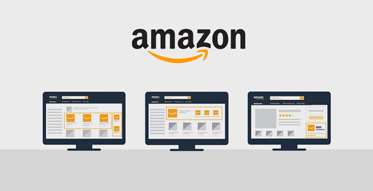
With The Motley Fool, a well-known financial advisory services company, having recently predicted that Amazon.com’s ad prices could go up next year, the million-dollar question is, is it still worth investing in Amazon marketing services, assuming that you could soon be looking at a greater investment? More importantly, can’t you simply optimize your listing, and (hope to) sell more? Well, the answer is “Yes” and “No”. Nothing beats the good old Amazon product listing optimization, agreed, but then, Amazon PPC ads come in a close second. They too can be a potential revenue driver, if leveraged well.
Corollary: Did you know that Amazon is now the third largest digital ad platform in the US? That’s yet another reason for you to consider outsourcing Amazon marketing services!
And guess what, the majority of the sellers haven’t taken to Amazon ads optimization, not yet, meaning, if you go about it the right way, you’d have the upper hand. On that note, here are some lesser-known tips to improve the results of your Amazon ads – tips that no Amazon advertising agency would want you to know:
1. Take to dayparting
They say “there’s a time and a place for everything” for a reason. Now, if you happen to know the time when your target audience is most likely to click and hopefully make a purchase, doesn’t it make sense to run your ads at exactly the same time? You bet! And that’s what dayparting or ad scheduling can help you with.
- Start off by breaking an entire week into, say, hourly blocks, and once you have determined when your audience is most likely to buy, use the very same blocks to schedule your ads.
- If you are not sure of the most suitable time, worry not, for you can always take to A/B testing and run near identical Amazon PPC campaigns throughout the day. And when the results begin to pour in, you can single out the time segments with enhanced activity.
- But why this fuss about identifying these segments in the first place, you may ask. Ads cost money, which, in all honesty, is better spent on clicks that are likely to convert. That’s like Amazon ads optimization 101. With prior knowledge of high-traffic hours, you can ensure that Amazon sponsored ads do you some real good, without you having to splurge.
- Ask just about anyone who has had a successful tryst with Amazon marketing services, and they’ll be quick to tell you that you shouldn’t think twice before turning off your ads for an entire day or two, especially if you notice a relatively dramatic shift in the buying behavior. In short, dayparting or Amazon ad scheduling can help make your money count.
Pro tip: Avoid the most competitive times, and rather schedule your Amazon advertising campaign for later in the day. Chances are that you’ll get your hands on a lower-priced bid.
2. Be willing to experiment
Each ad type has its fair share of advantages. Take headline search ads for example. Unlike the other available options, these ads let you use custom landing pages to your advantage. Similarly, with product display ads, you have this once-in-a-lifetime opportunity to take competitor targeting to a whole new level. To cut a long story short, give each of these ads a shot because you never know what might turn the tables for you.
3. Create a perfect mix
A manual campaign alone won’t serve the purpose, and neither would an automatic one. The latter, can, in fact, bid on irrelevant terms, causing you to lose out on money. It is only when you strike a balance that you can expect to make the most of your ads. First things first; automatic targeting or the results achieved thereafter can help you zero in on the keywords that do perform, making it possible for you to copy them onto a manual Amazon advertising campaign. Better still, if you run these campaigns in unison, you can identify the keywords that DO NOT work, commonly referred to as negative keywords.
Pro tip: Don’t let the name fool you. Negative keywords could be your saving grace. With these at your disposal, rest assured, you’ll appear for profitable and high-converting search terms, have more relevant keywords to work on, and can expect a far better CTR. A win-win for sure!
4. Focus on impressions
Yes, you want the audience to click on your ad and buy a product, understandable. That’s what Amazon PPC management is all about. But unless your ads are visible, there won’t be any clicks that follow. And that’s when impressions come into the picture. Call these a metric, if you will, but you ought to keep a close eye on impressions to be able to figure out how often does your ad appear on Amazon. And it goes without saying that the more impressions you get, the better your ads will perform. But before getting to the part where we tell you how to increase impressions, let’s try and understand the importance thereof:
- They offer a reality check of sorts. Are the keywords that you have been using (or plan to) effective enough for you to lay emphasis on? You won’t know.
- And what about negative keywords? Is it really that easy to identify them? For an Amazon PPC expert, yes, but for a seller, not so much.
- Also, does your product detail page have relevant content, as in the kind of content that’s in tandem with the search terms you have used? Again, impressions can clear the air once and for all.
Now that we have established that impressions do matter, let’s get down to getting more of these.

5. Study the ACoS
Advertising cost of sales or ACoS can paint a rather ambiguous picture. As in, a buyer could click on your ad, check out your product listing, and may or may not make a purchase. Unfortunately, you’d still have to shell out money for that click. However, if the very same buyer comes back later to buy the same product, but doesn’t click on the ad this time, you won’t be spending a penny, and would get a sale. Therefore, while it’s imperative for you to keep tabs on your advertising spend or the money you invest in Amazon advertising service, if you do decide to outsource, it is equally important, if not more, to only measure the total expenditure when you have the total sales on you.
6. Choose your ads wisely
If Google Adwords and CPCs have been burning a hole in your pocket, well, you are in for a treat. Try your hand at sponsored product ads, and in all possibility, you’ll be spending three times less than now. And the icing on the cake is that these ads are quite easy to work around – zero in on a product, decide on the keyword that you wish to target, and allocate a budget. Easier said than done. What if you want to target a specific audience? Would Amazon sponsored ads yield the desired results here?
Not necessarily. In this case, however, you can take full advantage of what are commonly referred to as Amazon product display ads. Now, there are two ways two go about it. Firstly, you can reach out to your target audience by appealing to their interests (interest-based targeting). Secondly, you can rather shift your focus to specific products (product-based targeting). Of course, both these options have their pros and cons. Weigh, and then make an informed decision. Not yet. There’s a third ad type that you can consider – headline search ads, which can give a much-needed boost to your brand awareness efforts.
7. Decide on a keyword match type
Let’s cut to the chase. There are three keyword match types that you can choose from, depending on what you are trying to accomplish.
-
- Broad match: These keywords would cost you less, and leave room for misspellings and synonyms as well. There’s a catch though. Your ads could appear for “n” number of ads, inviting unsolicited clicks, which would of course cost you money. Now these ads won’t be totally unrelated.
- Say, you are selling home decor items and are trying to rank for “decorative mason jars.” Your name won’t pop up when the customers search for “perfumes for women,” but yes, if they key in “mason jar sconces,” there’s this possibility of your ad getting a few clicks, which, much to your dismay, could defeat the very purpose.
- Phrase match: These are more specific, and can offer a fix, a strong one at that, helping you combat the unnecessary clicks generated in case of broad match. Again, misspellings are common. So, is it any different from broad match? Yes. For starters, you can control the word order. Meaning, if customers insert a term between the words you have chosen, your ad won’t appear, but, if they add a word before or after your keyword phrase, the ad will be visible and can be clicked on.
- Broad match: These keywords would cost you less, and leave room for misspellings and synonyms as well. There’s a catch though. Your ads could appear for “n” number of ads, inviting unsolicited clicks, which would of course cost you money. Now these ads won’t be totally unrelated.
- Exact match: This might cost you a fortune, but some say that it’s worth every penny. As the name suggests, you could soon be ranking on the exact keyword that you bid on. Also, exact match could be your best bet if you are working on a highly competitive keyword, one that everyone’s trying to rank for.
8. Be clear on your objectives
Having helped hundreds and thousands of sellers with our Amazon marketing services, here’s what we have deduced over the years, there’s no one-solution-fits-all approach that you can resort to. You’ll have to narrow down your options. Take for example, the underlying need to sell more. So, if that’s what you are aiming for, might we suggest that you let high-performing keywords take center stage? After all, if these keywords are already being searched for, and even better, bring clicked on, they are sure to get you more sales. Not to mention, the more sales you crack, the better your rankings will be, eventually. It’s more like killing two birds with one stone.
Other possible objectives and corresponding POAs could be:
- Are you looking forward to brand building? If that’s a yes, you need to take impressions seriously. As already discussed, impressions count, like literally, and even more so, if you were to create brand awareness.
- Alternatively, you could be vying for more traffic. Who isn’t, right? Jokes apart, you’d need to focus on keywords, yet again, but thankfully, this time, you won’t be breaking the bank. And that’s because you can simply opt for some broad match keywords, and well, that should do.
Amazon PPC ads can work wonders, but only if you know the drill, and in case you don’t, well, the very same ads could soon turn into your worst nightmare, adversely affecting your marketing budget. So, it’s important that you tread carefully. Better still, you can outsource Amazon PPC services to Data4Amazon, and get the most out of your ads. Whatever it is that you are looking forward to, boosting sales, increasing the organic rankings of highly competitive keywords, creating brand awareness for a product that you may have launched quite recently, or making your products visible as per the seasonal trends, rest assured every Amazon PPC consultant working on your project would address your individual requirements and pain points in the best way possible. Reach out to us at info@data4amazon.com, and do not forget to apprise us of your requirements. A gist should do, to begin with.



